- This topic is empty.
-
AuthorPosts
-
2024-11-13 at 5:25 pm #79863
FR4 is known for its durability, electrical insulation properties, and mechanical strength and is a standard material for printed circuit boards (PCBs). In this blog post, Hangzhou Blue Sun will share the insulation performance testing of FR4epoxy fiberglass sheet for sale, exploring the methods, parameters, and results that determine its effectiveness in electronic applications.
1. Understanding FR4 Epoxy Fiberglass Sheet
FR4 (Flame Retardant 4) is a composite material made from woven fiberglass cloth with an epoxy resin binder that exhibits high mechanical and electrical insulation properties. The material' s resistance to high temperatures and mechanical impact make it ideal for use in the electronics industry. FR4 sheets are characterized by their high dielectric strength, moisture resistance, and low thermal conductivity, allowing for reliable insulation in both ambient and elevated temperature conditions.
2. The Importance of Insulation Performance Testing
– Ensuring Operational Safety: Insulating properties prevent electrical shorts, reducing risks of fires or malfunctions.
– Enhancing Product Longevity: Effective insulation can extend the life of electronic components.
– Meeting Regulatory Standards: Various industry standards like UL94 for flame retardancy and IEC standards for insulation are mandatory for electronic products.
– Assessing Environmental Resilience: FR4' s insulation properties can vary with temperature and humidity, so testing in different environments is crucial.

3. Insulation Performance Test Methodologies
To assess the insulation capabilities of FR4 epoxy fiberglass sheets, a series of tests are conducted under standard and stress conditions. These tests include dielectric breakdown testing, surface resistance measurement, insulation resistance, and thermal aging tests.
a) Dielectric Breakdown Voltage Test
Dielectric breakdown testing assesses the maximum voltage FR4 can withstand before it fails electrically. The test is typically performed under controlled conditions, applying increasing voltage until breakdown occurs. This measurement provides the dielectric breakdown strength in volts per unit thickness (e.g., kV/mm).
– Test Setup: A sample of FR4 sheet is placed between two electrodes in a dielectric breakdown tester. The voltage is gradually increased until dielectric breakdown occurs.
– Parameters Measured: The dielectric strength (breakdown voltage per unit thickness) of FR4 sheets, typically around 20-30 kV/mm for standard FR4.
– Outcome: High dielectric breakdown values indicate strong insulation properties, suitable for high-voltage applications.
b) Surface and Volume Resistivity Testing
Surface and volume resistivity are crucial indicators of insulation performance in FR4 sheets, especially in high-humidity environments where moisture may compromise insulation.
– Surface Resistivity: Measures the resistance along the surface of the material. Higher surface resistivity indicates better insulation.
– Volume Resistivity: Indicates the resistance through the thickness of the material.
– Test Procedure: Using a resistivity meter, electrodes are placed on the sample' s surface (for surface resistivity) and across the material thickness (for volume resistivity). The resistance is measured in ohms.
– Results: FR4 typically exhibits high resistivity values (10^12 – 10^14 Ω·cm), affirming its effectiveness as an insulator.
c) Insulation Resistance Testing
Insulation resistance testing focuses on measuring the resistance of FR4 sheets to current leakage over time. This test is critical for applications where sustained insulation is essential for safe and reliable performance.
– Test Procedure: A DC voltage is applied across the FR4 sheet, and the resistance is measured to detect any leakage currents.
– Parameters: The insulation resistance, expressed in megaohms (MΩ) or higher, provides insights into the material' s ability to resist leakage under operational conditions.
– Significance: High insulation resistance (usually > 500 MΩ for FR4) is desirable, indicating effective prevention of current leakage.
d) Thermal Aging Test
Thermal aging tests assess the impact of prolonged exposure to high temperatures on FR4 insulation properties. FR4 sheets are often exposed to high temperatures in operational environments, making it critical to evaluate their stability and insulation under thermal stress.
– Test Procedure: Samples are subjected to continuous or cyclical heating to temperatures close to the material' s maximum rated temperature (usually 130-150°C for FR4). The dielectric and mechanical properties are measured after set intervals to assess deterioration.
– Parameters Measured: Dielectric strength, volume resistivity, and mechanical properties like flexural strength are typically analyzed.
– Outcome: Minimal degradation in insulation properties over time indicates robust thermal stability, making FR4 suitable for high-temperature applications.

4. Key Findings and Considerations in Insulation Testing
The insulation performance of FR4 epoxy fiberglass sheets demonstrates high effectiveness in a range of electronic applications. Key findings from insulation tests are:
– High Dielectric Strength: FR4' s high breakdown voltage ensures it can withstand significant voltage stress without failure.
– Superior Resistivity: Both surface and volume resistivity tests show that FR4 maintains high insulation even in humid environments.
– Strong Insulation Resistance: With high insulation resistance, FR4 reliably prevents current leakage, essential for long-term safety.
– Thermal Stability: FR4 performs well in thermal aging tests, with only minor reductions in insulation properties after prolonged high-temperature exposure.
Conclusion
FR4 epoxy fiberglass sheets have proven to be reliable and efficient insulation materials for electronic applications. The comprehensive insulation performance tests—dielectric breakdown, surface and volume resistivity, insulation resistance, and thermal aging—affirm the material' s suitability for high-voltage, humid, and high-temperature environments. By thoroughly testing insulation properties, manufacturers and engineers can ensure that FR4 will maintain its performance in diverse operating conditions, making it a preferred choice for high-performance PCBs and other electronic insulation applications.
https://www.bluesun-elec.com.cn/Insulation-Performance-Test-of-FR4-Epoxy-Fiberglass-Sheet.html
http://www.bluesun-elec.com.cn
Blue Sun -
AuthorPosts
- You must be logged in to reply to this topic.